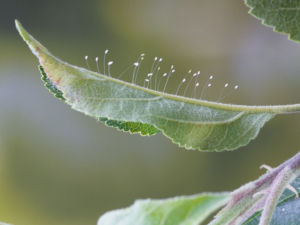The Lovely Lacewing
I approached a bush bean plant last year and spotted an insect on a leaf. I waved my hand to shew it away! Then I saw another, but this time I looked closer. A lacewing!
“Come back!”, I yelled to the first one, in vain.
How thrilling to be hosting a lacewing, and to see it in broad daylight. Common lacewings, from the large Chrysopidae family, are nocturnal. There are nearly 1,300 species of lacewings. Not to worry! You won’t likely be able to tell them apart.
Could there be a more beloved insect? Read further and then decide.
for work parties
Sat. March 25, 10-1, Plant Sale!
Please email to volunteer
freewayestatescommunityorchard@gmail
I first learned about Lacewings at a WSU continuing education conference on Organic Pest and Disease Management. These beautiful insects have fluttered into conversations many times since.
 You can look for their eggs now, They begin to hatch in March and continue through September. Notice the egg on a thread trick. Eggs are strategically laid near aphid activity. However, what lives mutualistically with aphids are ants, which feed on the aphid’s sweet excretions. The thread of the lacewing eggs prevents the ant from finding the eggs.
You can look for their eggs now, They begin to hatch in March and continue through September. Notice the egg on a thread trick. Eggs are strategically laid near aphid activity. However, what lives mutualistically with aphids are ants, which feed on the aphid’s sweet excretions. The thread of the lacewing eggs prevents the ant from finding the eggs.
 The lacewing larva have huge appetites, One larvae, throughout its three instar stages, can suck the body fluid of 250 leaf hoppers, 300-400 aphids, 11,200 spider mites and 6500 scale eggs. You can see why many farmers use Integrated Pest Management (IPM), which incorporates bio-control agents like lacewings. The idea is to reduce the use of chemical pesticides. Lacewing larvae, which look like tiny alligators, also dine on mealybugs, thrips, and pear psylla.
The lacewing larva have huge appetites, One larvae, throughout its three instar stages, can suck the body fluid of 250 leaf hoppers, 300-400 aphids, 11,200 spider mites and 6500 scale eggs. You can see why many farmers use Integrated Pest Management (IPM), which incorporates bio-control agents like lacewings. The idea is to reduce the use of chemical pesticides. Lacewing larvae, which look like tiny alligators, also dine on mealybugs, thrips, and pear psylla.
The larva pupates in an opaque spherical cocoon. The pupa is green and ushers the insect through the winter. Due to our mild weather in the Pacific Northwest, lacewings can have three to four generations per year.
Best host plants for this fabulous creature? Adult lacewings are found visiting nectar-producing, small-flowered plants such as members of the daisy family ( Asteraceae) and carrot family (Apiaceae). Examples of northwest native plants in these families are:
( Asteraceae) yarrow, pearly everlasting, pussytoes, common burdock
(Apiaceae) Queen Anne’s lace, cow parsnip, celery-leaf and Gray’s lovage, lomatium, yampah
Other references list these native plants as great choices for beneficial insects:
Spreading Dogbane, Rabbitbrush, Golden Rod, wild buckwheat (two native species are northern buckwheat (heart-leaf buckwheat, arrowleaf buckwheat ) Eriogonum compositum, and Snow buckwheat Eriogonum niveum (also a ground cover), Milkweeds, Coyote Mint, Western Hyssop, Stinging Nettle, Wild Rose and Lupine
Well, what’s the verdict? Should the lacewing be lauded? I think so!
Ruth
Resources:
Lacewings – WSU, crop protection (1993)
https://treefruit.wsu.edu/crop-protection/opm/lacewings/
WSU – Beauty with Benefits – Native Plants for Beneficial Insects
https://treefruit.wsu.edu/article/beauty-with-benefits-native-plants-for-beneficial-insects/


Beautiful story, I realize I have under-appreciated this “bug.”
Thanks, Ruth. I didn’t know about that bug!